 |
 |
|
 |
|
 |
|  |
|  |
|
 |
|
 |
|  |
|  |
|
 |
"And" <49341109@ntnu.edu.tw> wrote:
> > Asymmetric growth ring thickness. (a bent or curved branch will be thick on one
> > side and thin on the other)
>
> Not uniform ring thickness I wonder how to implement. Basically, if it can
> implement in POV-Ray, than it can do in principle. My Java program can output
> some data and it can be numerous like the attachment.
You could just an angle value to multiply the radius or thickness by.
use atan2, and make sure the output of the function varies from 0 to 1 from one
side of the unit circle to the other. then multioply by some amount of bend and
then add 1, to get a range from 1 to N.
If you know how to do things like geometric inversion, you could use that to
distort the cylinder like a torus is distorted into a Dupin cylide.
There may be other ways as well.
Post a reply to this message
|
 |
|  |
|  |
|
 |
|
 |
|  |
|  |
|
 |
"And" <49341109@ntnu.edu.tw> wrote:
> "Bald Eagle" <cre### [at] netscape net> wrote:
>
> > Alternating light-dark / thick-thin growth rings
>
> I'm not sure. Is this the previous item I reply but I interpret your meaning
> wrong?
I think there are several aspects of tree rings that are all sort of
interrelated.
https://www.theforestacademy.com/tree-knowledge/annual-growth-rings/
When you abrade wood, erode it - like with driftwood, or stain it, you get an
enhancement of the grain. This is due to the alternating hard/soft regions, and
usually the soft regions are light, and the harder regions are more brown.
Maybe xylem and phloem?
> > Holes due to boring insects
> > "checking" (cracks) due to splitting when cut wood is rapidly dried
>
> Are you a professional person? Maybe we can discuss it. I don't know so much
> about it.
I don't do anything with wood for a living, but I've felled, sawn, and worked
with lots of different wood. And made plenty of mistakes.
https://blog.spib.org/shakes-checks-and-splits-in-dimension-lumber/
https://thetoolscout.com/how-to-dry-wood-fast-for-woodworking/
> > Then there's the fun of formulating pigment/texture maps for all of the
> > different species... ;)
>
> My living country don't have much ... oak, pine ..., which species I see in the
> book. (Not the same)
> I'm not very familiar with these.
Thankfully there are now millions of images that you can search to see what any
types of wood look like, and all of the variations and defects, some of whick
are highly sought after - liked spalted wood. net> wrote:
>
> > Alternating light-dark / thick-thin growth rings
>
> I'm not sure. Is this the previous item I reply but I interpret your meaning
> wrong?
I think there are several aspects of tree rings that are all sort of
interrelated.
https://www.theforestacademy.com/tree-knowledge/annual-growth-rings/
When you abrade wood, erode it - like with driftwood, or stain it, you get an
enhancement of the grain. This is due to the alternating hard/soft regions, and
usually the soft regions are light, and the harder regions are more brown.
Maybe xylem and phloem?
> > Holes due to boring insects
> > "checking" (cracks) due to splitting when cut wood is rapidly dried
>
> Are you a professional person? Maybe we can discuss it. I don't know so much
> about it.
I don't do anything with wood for a living, but I've felled, sawn, and worked
with lots of different wood. And made plenty of mistakes.
https://blog.spib.org/shakes-checks-and-splits-in-dimension-lumber/
https://thetoolscout.com/how-to-dry-wood-fast-for-woodworking/
> > Then there's the fun of formulating pigment/texture maps for all of the
> > different species... ;)
>
> My living country don't have much ... oak, pine ..., which species I see in the
> book. (Not the same)
> I'm not very familiar with these.
Thankfully there are now millions of images that you can search to see what any
types of wood look like, and all of the variations and defects, some of whick
are highly sought after - liked spalted wood.
Post a reply to this message
|
 |
|  |
|  |
|
 |
|
 |
|  |
|  |
|
 |
Browse your links roughly. Thank you.
Careless reading because I still effort on existed plane.
This one I cancelled the vertical pattern because it looks artifact.
And I try using several pattern (vs different age) superposition , because I
would like maintain the fiber length at different position.
This one about 0.1m.
Post a reply to this message
Attachments:
Download 'show tree function test several f with bumps l0.10.png' (813 KB)
Preview of image 'show tree function test several f with bumps l0.10.png'
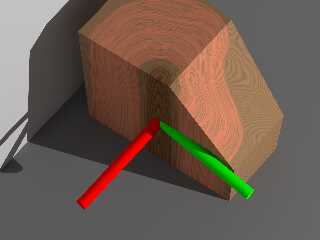
|
 |
|  |
|  |
|
 |
|
 |
|  |
|  |
|
 |
And this one about 0.01m.
With some artifact during the position it shows staggered.
I should think a better method.
Post a reply to this message
Attachments:
Download 'show tree function test several f with bumps l0.01.png' (863 KB)
Preview of image 'show tree function test several f with bumps l0.01.png'
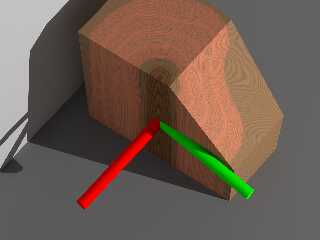
|
 |
|  |
|  |
|
 |
|
 |
|  |
|  |
|
 |
I'm satisfied with this one, but with heavier coverage it is not so natural.
And variety for the height is a problem (I cancelled the original form, the new
one is list-to-do).
I found pigment_map should be a better method to composite the base color with
the thin fiber. Thus the fiber can be a darker color than the base. I still use
the 'average', but I will rewrite it.
If the output pigment want to maintain the fiber length, wood heart is another
challenge, I have tried some method, but no perfect one.
Post a reply to this message
Attachments:
Download 'show tree function test bumps l0.01 thickness0.07year near.png' (1759 KB)
Preview of image 'show tree function test bumps l0.01 thickness0.07year near.png'
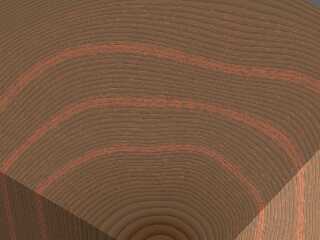
|
 |
|  |
|  |
|
 |
|
 |
|  |
|  |
|
 |
"Bald Eagle" <cre### [at] netscape net> wrote:
> "And" <49341109@ntnu.edu.tw> wrote:
> > "Bald Eagle" <cre### [at] netscape net> wrote:
> "And" <49341109@ntnu.edu.tw> wrote:
> > "Bald Eagle" <cre### [at] netscape net> wrote:
> When you abrade wood, erode it - like with driftwood, or stain it, you get an
> enhancement of the grain. This is due to the alternating hard/soft regions, and
> usually the soft regions are light, and the harder regions are more brown.
Thanks for this knowledge.
>
> > > Holes due to boring insects
> > > "checking" (cracks) due to splitting when cut wood is rapidly dried
> >
> > Are you a professional person? Maybe we can discuss it. I don't know so much
> > about it.
>
> I don't do anything with wood for a living, but I've felled, sawn, and worked
> with lots of different wood. And made plenty of mistakes.
Here is no chance to fell a tree, not to mention I'm living in a city. Such a
thing is secluded to me, so I have respect to the people who can do these
things.
> > > Then there's the fun of formulating pigment/texture maps for all of the
> > > different species... ;)
That's right, I will use pigment_map, but this is a picture I rendered, improved
the defect yesterday, and this is a two layered(in fact average of two) pattern
with different fiber length, eliminate some artifact about the coherence. net> wrote:
> When you abrade wood, erode it - like with driftwood, or stain it, you get an
> enhancement of the grain. This is due to the alternating hard/soft regions, and
> usually the soft regions are light, and the harder regions are more brown.
Thanks for this knowledge.
>
> > > Holes due to boring insects
> > > "checking" (cracks) due to splitting when cut wood is rapidly dried
> >
> > Are you a professional person? Maybe we can discuss it. I don't know so much
> > about it.
>
> I don't do anything with wood for a living, but I've felled, sawn, and worked
> with lots of different wood. And made plenty of mistakes.
Here is no chance to fell a tree, not to mention I'm living in a city. Such a
thing is secluded to me, so I have respect to the people who can do these
things.
> > > Then there's the fun of formulating pigment/texture maps for all of the
> > > different species... ;)
That's right, I will use pigment_map, but this is a picture I rendered, improved
the defect yesterday, and this is a two layered(in fact average of two) pattern
with different fiber length, eliminate some artifact about the coherence.
Post a reply to this message
Attachments:
Download 'show tree function two fiber length 0.017m 0.048m.png' (1763 KB)
Preview of image 'show tree function two fiber length 0.017m 0.048m.png'
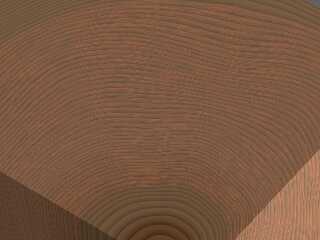
|
 |
|  |
|  |
|
 |
|
 |
|  |
|  |
|
 |
Before continue the pigment_map and color, I tried a incredible detail idea
yesterday that I thought recently. Can be a new target to complete in the
future.
It is the knot.
But I'm willing to develop this feature with not so accurate shape only, I'd
like to implement it with (as much as possible) simple mathematical formula.
https://www.researchgate.net/figure/Longitudinal-section-through-a-tree-trunk-and-branch-Mueller-et-al-2006_fig1_274618
751
Post a reply to this message
Attachments:
Download '2d tree knot test.png' (1405 KB)
Preview of image '2d tree knot test.png'
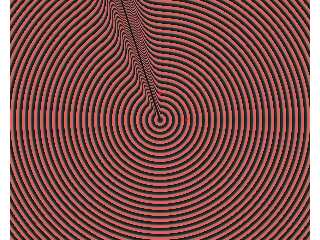
|
 |
|  |
|  |
|
 |
|
 |
|  |
|  |
|
 |
Composite pigment_map and functions is more cumbersome than I think. I only
treat preconceived it easy.
The earlywood color and merge effect is not bad, but maybe strange at latewood.
Not know, should look the side cross section, but for the purpose of trying the
pigment/color_map as quickly, I don't fix that varying function (vs height) yet.
This picture take 18m47s render time, It will slow down when combine more
(layer, concept)s.
And my main method is distinguish the heartwood, inner-sapwood, mid-sapwood,
outer-sapwood..., this one I only detail the mid-sapwood.
Post a reply to this message
Attachments:
Download 'show tree function.png' (830 KB)
Preview of image 'show tree function.png'
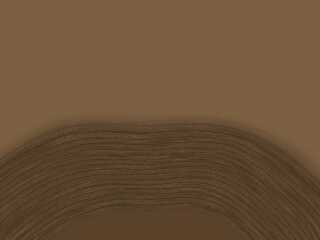
|
 |
|  |
|  |
|
 |
|
 |
|  |
|  |
|
 |
"And" <49341109@ntnu.edu.tw> wrote:
> This picture take 18m47s render time, It will slow down when combine more
> (layer, concept)s.
That seems like a very long time for such a simple render. I would imagine that
you can get a similar result a lot faster if the troubles were identified and
optimised. I like to consult Inigo Quilez, and Martijn Steinrucker (Art of
Code), since their approach to computer graphics is very different, and forces
me to consider different approaches and ways to simplify and optimize any
function-based code I'm interested in writing.
TOK always has a way of slicing through a lot of these problems like a laser,
but I think it's very educational to explore a number of approaches before
others offer up solutions of their own.
> And my main method is distinguish the heartwood, inner-sapwood, mid-sapwood,
> outer-sapwood..., this one I only detail the mid-sapwood.
As slow as it is, I think that middle layer is looking great, and your progress
in this project is definitely showing incremental successes! :)
Post a reply to this message
|
 |
|  |
|  |
|
 |
|
 |
|  |
|  |
|
 |
"Bald Eagle" <cre### [at] netscape net> wrote:
> "And" <49341109@ntnu.edu.tw> wrote:
>
> > This picture take 18m47s render time, It will slow down when combine more
> > (layer, concept)s.
>
> That seems like a very long time for such a simple render. I would imagine that
> you can get a similar result a lot faster if the troubles were identified and
> optimised. I like to consult Inigo Quilez, and Martijn Steinrucker (Art of
> Code), since their approach to computer graphics is very different, and forces
> me to consider different approaches and ways to simplify and optimize any
> function-based code I'm interested in writing.
Thank you. I never develop my (not chinese)social circle besides news.povray.
Maybe I can try someday.
And, that rendered picture is a 3D one, not a pattern. It turn on radiosity and
rendered using my notebook, so I'm not suspect this situation too much.
> TOK always has a way of slicing through a lot of these problems like a laser,
> but I think it's very educational to explore a number of approaches before
> others offer up solutions of their own.
>
> > And my main method is distinguish the heartwood, inner-sapwood, mid-sapwood,
> > outer-sapwood..., this one I only detail the mid-sapwood.
>
> As slow as it is, I think that middle layer is looking great, and your progress
> in this project is definitely showing incremental successes! :)
Thanks. net> wrote:
> "And" <49341109@ntnu.edu.tw> wrote:
>
> > This picture take 18m47s render time, It will slow down when combine more
> > (layer, concept)s.
>
> That seems like a very long time for such a simple render. I would imagine that
> you can get a similar result a lot faster if the troubles were identified and
> optimised. I like to consult Inigo Quilez, and Martijn Steinrucker (Art of
> Code), since their approach to computer graphics is very different, and forces
> me to consider different approaches and ways to simplify and optimize any
> function-based code I'm interested in writing.
Thank you. I never develop my (not chinese)social circle besides news.povray.
Maybe I can try someday.
And, that rendered picture is a 3D one, not a pattern. It turn on radiosity and
rendered using my notebook, so I'm not suspect this situation too much.
> TOK always has a way of slicing through a lot of these problems like a laser,
> but I think it's very educational to explore a number of approaches before
> others offer up solutions of their own.
>
> > And my main method is distinguish the heartwood, inner-sapwood, mid-sapwood,
> > outer-sapwood..., this one I only detail the mid-sapwood.
>
> As slow as it is, I think that middle layer is looking great, and your progress
> in this project is definitely showing incremental successes! :)
Thanks.
Post a reply to this message
|
 |
|  |
|  |
|
 |
|
 |
|  |




![]()